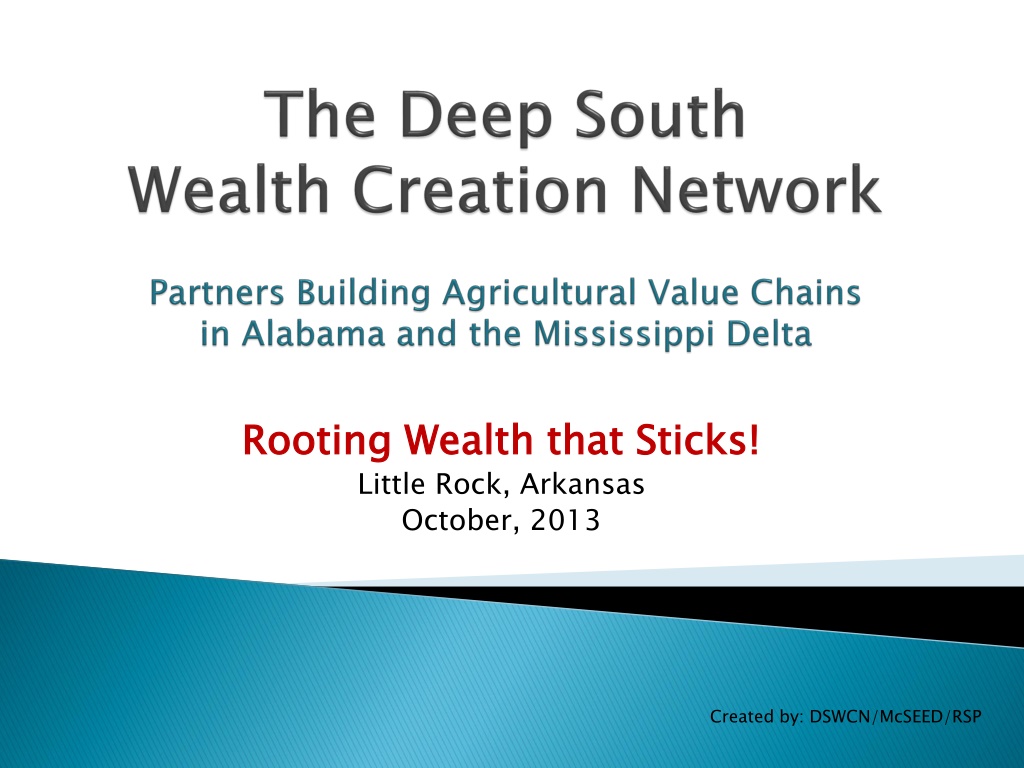Deep South Wealth Creation Network Overview
The Deep South Wealth Creation Network, spearheaded by DSWCN/McSEED/RSP, aims to address economic challenges in Deep South communities like Rural Mississippi and Alabama. Through initiatives like the Value Chains & Forms of Wealth project and collaborations with organizations such as ASAN and National Wildlife Federation, the network seeks to combat systemic issues like racism, poverty, and depopulation. By focusing on sustainable agriculture, education, and economic development, these efforts strive to uplift local communities and create lasting change in the region.
Download Presentation

Please find below an Image/Link to download the presentation.
The content on the website is provided AS IS for your information and personal use only. It may not be sold, licensed, or shared on other websites without obtaining consent from the author.If you encounter any issues during the download, it is possible that the publisher has removed the file from their server.
You are allowed to download the files provided on this website for personal or commercial use, subject to the condition that they are used lawfully. All files are the property of their respective owners.
The content on the website is provided AS IS for your information and personal use only. It may not be sold, licensed, or shared on other websites without obtaining consent from the author.
E N D
Presentation Transcript
Rooting Wealth that Sticks! Little Rock, Arkansas October, 2013 Rooting Wealth that Sticks! Created by: DSWCN/McSEED/RSP
Introduce The Deep South Wealth Creation Network Provide a brief overview of the Value Chains & Forms of Wealth Provide an Overview of the Alabama/ Mississippi Value Chain Project Created by: DSWCN/McSEED/RSP
Alabama Sustainable Agriculture Network (ASAN) National Wildlife Federation Perry County Center for Economic Development The Cottage House The United Christian Community Association Children s Defense Fund Mississippi Action for Community Education Quitman County Development Organization Southern Rural Black Women s Initiative Winston County Cooperative Mileston Cooperative Tougaloo College Alabama Partners Funding Partners Ford Foundation Yellow Wood Associates Center for Rural Entrepreneurship Funding Partners Mississippi Partners Supporting Partners McIntosh SEED Rural Support Partners Created by: DSWCN/McSEED/RSP Supporting Partners
DEEP SOUTH WEALTH CREATION NETWORK DEEP SOUTH WEALTH CREATION NETWORK Created by: DSWCN/McSEED/RSP
Apathy Rural Mississippi: 25.8% Rural Alabama: 21.8% Low Education Rates Low Ranking on the Human Development Index 2010. USDA Economic Research Service Limited History of Collaboration Systemic Racism Entrenched Poverty Systemic Racism Systemic many formal systems, institutions, and policies is the underlying cause of many of these issues. It continues to hinder economic development efforts in the Deep South. Systemic racism racism - still prevalent in Exodus of Youth Depopulation Accompanying Issues Created by: DSWCN/McSEED/RSP
. Mississippi Mississippi Alabama Alabama Source USDA African American African American African American African American Total Total Total Total 2007 Census of Agriculture 41,959 41,959 5,409 5,409 48,753 48,753 2,789 2,789 Total # of Farms Total # of Farms 273 acres 273 acres 113 acres 113 acres 185 acres 185 acres 105 acres 105 acres Average Farm Size Average Farm Size % of Farms that earn less than $2,500 in annual sales % of Farms that earn less than $2,500 53% 53% 56% 56% 46% 46% 53% 53% in annual sales Nationwide, 1.3% of farm operators in the US are African-American specifically, 32,938 African-American operated farms. Mississippi Land Rich but Cash Poor! Mississippi and Alabama Alabama are home to 25 25% % of these farms. Created by: DSWCN/McSEED/RSP
Anticipated Results 1. Increase income for all farmers 2. Increase income for low- wealth minority farmers, 3. Capitalize on the increase in statewide vegetable and fruit production 4. Improve, connect and fully utilize existing built capital 5. Increase financial capital within the region. Anticipated Results Potential Potential Minority farmers still own substantial amounts of land Many have much more capacity on the supply side A robust agricultural supply chain could serve markets both inside and outside the Delta Some minority (and many white) farmers already export crops and value-added products to corporations (e.g., Mars) If organized, producers could capture more substantial regulated market opportunities. Created by: DSWCN/McSEED/RSP
Implementation Plan Implementation Plan 1. Utilize a systems approach to economic development. Use value chains as the vehicle to generate multiple forms of wealth. 2. Assess, plan, and measure the development of value chains by focusing on increasing the eight forms of capital, local ownership and control, and low-income livelihoods the aim of WealthWorks value chains Created by: DSWCN/McSEED/RSP
A network of businesses, non-profit organizations, and collaborating players who work together to satisfy market demand for specific products or services. Because value chains are built in response to market demand and involve clear and constant communication, they can be more responsive and innovative than traditional supply chains. . Created by: DSWCN/McSEED/RSP
Moves from isolated projects to a systems approach Provides access to larger more diverse markets Gives farmers the tools, capacities, support and connections to significantly improve their own livelihoods Provides opportunities for food & farm entrepreneurs Creates multiple forms of wealth that is locally owned, controlled and reinvested into rural communities Created by: DSWCN/McSEED/RSP
Network Benefits Working as network helps to move us beyond institution or single move us beyond single- solution approaches single- -solution approaches Provides group members with the collective power and support scale of their individual efforts. the collective power and support necessary to deepen the impact and expand the Creates an opportunity for a regional network to foster collaboration and innovation to improve the livelihoods of rural people improve the livelihoods of rural people in the Deep South. The long-term development of networked value chains connecting sub-regional value chains across both states will lead to greater access to markets as the sustainable supply of products. greater access to markets, as well sustainable supply of products. Created by: DSWCN/McSEED/RSP
This is the Story of Land, Knowledge, Partnerships and Wealth Creation This is the Story of Land, Knowledge, Partnerships and Wealth Creation Created by: DSWCN/McSEED/RSP
Face-to-face visit with each participating organization Face-to-Face visit with established regional non-profit grassroots organizations: Southern Echo Federation of Southern Coops Children s Defense Fund Tour of communities Meetings with community members Meetings with local farmers McIntosh S.E.E.D. and Rural Support Partners compiled the information gained from the interviews and used it as a catalyst to formulate the implementation strategy implementation strategy. . Created by: DSWCN/McSEED/RSP
Research/analyze the various components of the value chain: product demand, production capacity, aggregation/ distribution infrastructure, etc. Engage, inform, & connect value chain stakeholders Discover connections, common visions and possible ways project groups can work together Develop individual & collective action plans Strengthen our skills, knowledge & capacities Document tools & lessons to help other groups working to construct value chains Created by: DSWCN/McSEED/RSP 16
Assessing Processing, Aggregation, and Distribution (PAD) Assessing Processing, Aggregation, and Distribution (PAD)
Customer Demand Customer Demand Production Production Access to capital? Current production capacity? Farm plans? Labor needs? Access to land? Storage capacity? Transportation? Who are potential buyers? Consumers? What product(s) do the buyers want to buy? What are the cost factors? Certification requirements? Grading? Liability? Environmental impact? Soil samples? EPA? Bidding Process Processing What facilities already exist? Location? Produce procurement? Cooling systems? On-site/Facility? Processing Aggregation and Distribution Aggregation and Distribution Producers pay system? Infrastructure: Existing and needed? What produce can be field processed and what needs to be facility processed? Created by: DSWCN/McSEED/RSP
Value Chain Hotspot # Value Chain Hotspot #1 1: Southeast Alabama : Southeast Alabama Project Partners: Counties in Hot Spot: Macon: 127 farms,17,313 acres Lowndes: 134 farms, 22,342 acres Coffee, Geneva, Houston, Henry, Barbour, Bullock, Montgomery, Lee, Autauga Potential Markets and Buyers Include: Schools & Universities Project Partners: Cottage House and ASAN Counties in Hot Spot: Potential Markets and Buyers Include: Wholesale Buyers Direct to Consumer Dixie - Eufaula AL Piggly Wiggly Clayton AL Food Warehouse / Super Save Ozark AL Tiger Food Calhoun Foods Food Depot Food Outlet Grocery Outlet Save-a-Lot Hometown Grocery Walmart C.H. Robinson Cracker Barrel Piccadilly The Fresh Market Montgomery AL: peaches, berries, collards, and kale. Wallace Community College Cottage House Youth Market Tuskegee University Clayton Farmers Market Barbour County city and public schools Clio Senior Market Eufaula Farmers Market Autauga producers in discussion with Alabama State University School Road Side Stand Browntown producers in discussion with Montgomery public school district Fairview market Created by: DSWCN/McSEED/RSP
Value Chain Hotspot #2: West Alabama and East Mississippi Value Chain Hotspot #2: West Alabama and East Mississippi Project Partners: TUCCA, NWF, Winston County Self-Help Group Counties in Hot Spot: West Green: 118 farms, 24680 acres Sumter: 166 farms, 26,412 acres Perry: 134 farms, 13,284 acres Dallas: 170 farms, 12,941 acres Wilcox: 155 farms, 10,200 acres Choctaw, Marengo, Hale: 134 farms, 13,774 acres Opportunity to move into Mobile, Baldwin and Lauderdale Birmingham/Jefferson County in the future Project Partners: Counties in Hot Spot: West Alabama Counties Alabama Counties East Mississippi Counties: Noxubee: 127 farms, 11,185 acres Kemper: 129 farms, 20,430 acres Lauderdale Winston East Mississippi Counties: Potential Markets and Buyers Include: Wholesale Buyers Potential Markets and Buyers Include: Institutions Direct to Consumer County/City School Systems Universities Area Nursing Care Facilities Area Hospitals In two AL counties, Child Nutrition Directors need a supply of fresh food for more than 6,000 students daily. White Oak Pastures: farm retails, online stores, Whole Food Tallgrass Beef Company: restaurants, online and retail stores US Wellness (international) Fresh Market, AL Earth Fare, AL Kroger, MS, Rainbow Natural Food Co-op, MS City Meat in Jefferson County, AL Wal-Mart C.H. Robinson: organic MS blueberries & purple hull peas Cracker Barrel and Piccadilly Small local grocery stores Highway 45 Farmers Market: Mobile & Baldwin Counties AL Community Supported Agriculture Internet Sales Wholes & Halfs Main Street Birmingham Project in Jefferson County, AL Created by: DSWCN/McSEED/RSP
Value Chain Hotspot #3: Mississippi Delta Value Chain Hotspot #3: Mississippi Delta Project Partners: Project Partners: Children s Defense Fund, Mileston Cooperative, and Southern Rural Black Women s Initiative Counties in Hot Spot: Hinds: 228 farms, 24,262 acres Madison: 186 farms, 16,542 acres Holmes: 198 farms, 25,310 acres Humphreys, Washington, Bolivar, Leflore, Quitman, Coahoma, Attala, Yazoo, Sharkey Counties in Hot Spot: Potential Markets and Buyers Include: Wholesale Buyers Potential Markets and Buyers Include: Institutions Direct to Consumer Delta Health Alliance Delta Fresh Foods Roadside stands Mississippi Department of Education Cracker Barrel U-Pick Piccadilly Farmers markets Mississippi Department of Health 14 casinos across Mississippi Walmart - C.H. Robinson: organic blueberries and purple hull peas Opportunity to move produce to market at the Washington County Public Schools in Greenville. Created by: DSWCN/McSEED/RSP
Phase II: Value Chain Construction October 2012 - June 2013 Establish a regional network Develop and move value chains across the three hot spots Generate additional value chain funding & investment Develop hands-on Value Chain tools and processes Identify broader local, regional and national policies and systems that help and hold back these efforts Created by: DSWCN/McSEED/RSP
Livelihood Impact Livelihood Impact Pilot: Growing Protocols One growing season and one sub-region Farmers A & B followed protocols exactly, and saw a significant increase in product yield versus Farmers C & D, who did not. Project partners will start utilizing the growing protocols with local farmers across growing seasons. Each will track which farmers are and are not using growing protocols. Growing protocols have also begun to forge unprecedented working partnerships between farmers and horticulturalists from academia parties who have not traditionally worked well together in this region. Created by: DSWCN/McSEED/RSP
Launched three fully functioning agricultural value chains Implemented and documented universal growing protocols Trained and prepared farmers for GAP and GHP certifications Partnered with existing aggregators Partnered with city and county officials Partnered with Tuskegee University, Tougaloo University, and Alcorn State University Recruited additional farmers Gained access to diverse markets Created by: DSWCN/McSEED/RSP
Continue to develop well-managed and sustainable value chains Increase the participation and income of low-capacity producers Increase efficiency and sustain The Deep South Wealth Creation Network Document and disseminate replicable tools and processes Develop an informed policy agenda and working relationships with regional and national policy organizations Created by: DSWCN/McSEED/RSP
Organized 50 small minority farmers and created entry points to wholesale markets At close of 2013, in just one year, will collectively have generated over $250,000 in sales of collards greens, turnips, sweet potatoes, cabbages, and pink-eye peas to high-end restaurants, schools, and grocery stores Started training on a universal farming protocol to maximized product yield Provided mentorship opportunities for youth interested in agricultural work, closing inter-generational gaps Begun to create job opportunities within local communities to provide on-farm support Created by: DSWCN/McSEED/RSP
Capital Building Results Capital Building Results Improved business skills for farmers, new skills to sell into wholesale markets, and USDA Certification Intellectual Intellectual Training and implementation of universal growing protocols and sustainable production practices across the region Individual Individual A collaborative network, stronger relationships among farmers and organizations working across the region, and relationships with new customers Social Social Natural Natural New sustainable production practices in the region Shared access to equipment, establishment of hoop houses, and reclaimed vacant buildings for processing sites Built Built New understanding of the policies that help or hinder institutions from supporting growth of local food value chains Political Political New sources of loan capital identified for the region s farmers and connection of value chains to new foundations investors Financial Financial Created by: DSWCN/McSEED/RSP
Local ownership and control Local ownership and control Better livelihoods Better livelihoods Shared equipment purchases $250,000 in sales already moved through the value chain Shared liability insurance Market development New jobs for young people- and others New local businesses Shared labor (i.e., The Green Team) New business opportunities for local residents (i.e. sale of transplants) Placed more underutilized acreage into production to meet market demand Created by: DSWCN/McSEED/RSP
1) 1) Developing value chains requires significant time and on financial resources for both farmers and value chain intermediaries Up-front capital investment is needed for low-income farmers for tools and equipment/Up-front financial support is needed for intermediaries to manage all of the moving parts of the value chain. Developing value chains requires significant time and on- -the financial resources for both farmers and value chain intermediaries the- -ground ground 2) 2) Developing a regional network to support value chain construction, requires a foundation of trust and relationships between various value chain actors. Developing a regional network to support value chain construction, requires a foundation of trust and relationships between various value chain actors. 3) 3) We ve discovered a few general best practices for supporting the development of local food value chains: Work with intermediaries whose organizational focus is in agriculture Encourage intermediaries to offer ongoing support to farmers Investing in a local aggregator and horticulturalist can expedite the value chain construction process We ve discovered a few general best practices for supporting the development of local food value chains: Created by: DSWCN/McSEED/RSP
Labor is 40% of what groups need for success MileSton bringing 2 students/farm The Cottage House utilized prison re-entry program Green Team created and travels farm-to-farm to assist growers with farming needs (e.g., planting, harvesting, equipment operation, training) Time must be considered Labor is 40% of what groups need for success Must develop and bridge a business plan with the needs of the value chain Marketing, finances, record keeping Be patient for building structure because the work is so multi-faceted Must develop and bridge a business plan with the needs of the value chain Want to find a better method for data collection Important to take data that caters to value chain s needs Data also shows farmers that making money is possible, if they follow protocols Want to find a better method for data collection Protocols can potentially retain and attract farmers Once they are informed about the level of demand in the market, compare and contrast profit based on protocols > Following protocols can increase yield by at least 40% > Following protocols maximize profits > It ensures that the customer is getting what they want Protocols can potentially retain and attract farmers Created by: DSWCN/McSEED/RSP
Expanding to larger markets such as Belle Foods, Walmart, Sysco, and Red Diamond Test and documenting growing protocols across the network Train new farmers and help them attain GAP Certification Partnering with the COADY Institute to increase visibility and recognition of the Network Structure and expand Steering and Fundraising Committees to sustain the Network Created by: DSWCN/McSEED/RSP
Pride is returning to our farmers. They re feeling ownership. A sense of community has returned Partnerships with other co-ops are developing Created by: DSWCN/McSEED/RSP
A New Way of doing economic development that shows positive impacts in the livelihoods of low-income people living in Rural Communities! Created by: DSWCN/McSEED/RSP

 undefined
undefined





























